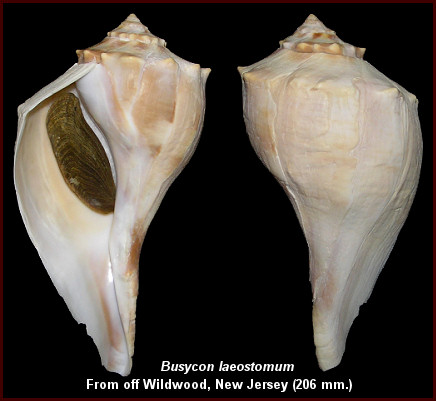| An Obscure Whelk - Busycon laeostomum Kent, 1982 |
| By Bill Frank and Harry G. Lee |
| Note: Whelk DNA sequencing since this article was published suggests that all living sinistral whelks of the western Atlantic are conspecific [of the same species], Busycon perversum (Linnaeus, 1758) being the oldest available nomen. |
| In the last Shell-O-Gram
we took a brief look at the tangled taxonomy of the well known
left-handed Busycon
whelks, (sub-genus Sinistrofulgur)
found along the U. S. Atlantic and Gulf Coasts and the names
which have been applied to them: Busycon
contrarium (Conrad, 1840), B.
sinistrum Hollister, 1958, B.
perversum (Linnaeus, 1758), and B.
perversum pulleyi Hollister, 1958. An additional less common (and much less well known) but equally puzzling species (B. laeostomum Kent, 1982) was described from shells occasionally collected offshore from southern New Jersey to northern Virginia. This whelk had at times been referred to as either a sinistral form of B. carica or as B. contrarium (hereinafter referred to as B. sinistrum), and was not addressed by Solomon Hollister in his 1958 treatise on the genus Busycon. This was probably due, in part, to the lack of well preserved specimens in museums at that time.
Busycon laeostomum can be differentiated from B. sinistrum by the shell shape (the latter is more slender and has a more angular shoulder), the development of tubercles on the shoulder (in the latter frequently elongated into prominent spines), the nature of the external spiral cords and aperture lirae (in the latter more well developed), the shape of the columella (in the latter more slender and relatively straight), and the color of the shell (8 of the 13 types of B. laeostomum had a pure white shell). Of note, a comparison of pure white B. sinistrum with normal B. sinistrum showed them to be indistinguishable except for color - suggesting that B. laeostomum is not just a white-shelled morph of B. sinistrum. Busycon laeostomum differs from B. carica not only in being sinistral and the nature of the periostracum, but by the spire angle, the shape of the anal ridge (weaker in the former), and shell coloration (both externally and within the aperture). In addition, the geographic and bathymetric ranges of the two differ in that B. carica has a much wider range and is found both intertidally and offshore, while B. laeostomum has a much more restrictive range and live specimens have only been found subtidally. Additionally, no pure white specimens of B. carica have been reported. As an added note, the difference in handedness may prevent copulation between the two species, or if interbreeding were possible, reduce gene flow. If successful mating were possible between the two morphs, egg capsules might occasionally be found containing both sinistral and dextral individuals. Gill (1867: 144) examined over 500 B. carica egg capsules and found only dextral individuals. So what is B. laeostomum - an obscure new species, a sinistral B. carica, a form/sub-species of B. sinistrum, or a hybrid? The examination of a badly beach-worn specimen from the type locality (Stone Harbor, NJ: circa. 1982), in the collection of H. G. Lee, is consistent with Bretton Kent's diagnosis. The shell has the general appearance of a sinistral B. carica and would not likely be mistaken for B. sinistrum. (Illustrated above is a live collected specimen which has just recently become available.) The collection of further specimens may provide a definitive answer as to the taxonomic status of B. laeostomum. An exhaustive review of the ample fossil record of the left-handed whelks should be considered if we are going to better understand this enigmatic form. In any case, if you have this shell in your collection, you should consider yourself lucky - as, whatever its taxonomic status, it is apparently quite a rare shell. References Cited: Gill, T., 1867. On the genus Fulgur and its allies. American Journal of Conchology 3: 141-152. <http://biodiversitylibrary.org/page/6658754> Hollister, S. C., 1958. A review of the genus Busycon and its allies, Pt. 1. Palaeontographica Americana 4(28): 1-126. <http://biodiversitylibrary.org/page/10693643> Kent, B. W., 1982. An overlooked Busycon
whelk (Melongenidae) from the eastern United States. The Nautilus 96(3):99-104.
16 July.
<http://biodiversitylibrary.org/page/8497660> |
